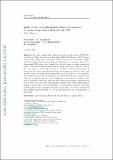Files in this item
Study of the three-dimensional shape and dynamics of coronal loops observed by Hinode/EIS
Item metadata
| dc.contributor.author | Syntelis, P. | |
| dc.contributor.author | Gontikakis, C. | |
| dc.contributor.author | Georgoulis, M. K. | |
| dc.contributor.author | Alissandrakis, C. E. | |
| dc.contributor.author | Tsinganos, K. | |
| dc.date.accessioned | 2016-09-05T12:30:09Z | |
| dc.date.available | 2016-09-05T12:30:09Z | |
| dc.date.issued | 2012-10 | |
| dc.identifier | 245502797 | |
| dc.identifier | 66de5129-231c-4827-9486-6ea85f64db8a | |
| dc.identifier | 84867520639 | |
| dc.identifier.citation | Syntelis , P , Gontikakis , C , Georgoulis , M K , Alissandrakis , C E & Tsinganos , K 2012 , ' Study of the three-dimensional shape and dynamics of coronal loops observed by Hinode /EIS ' , Solar Physics , vol. 280 , no. 2 , pp. 475-489 . https://doi.org/10.1007/s11207-012-0026-5 | en |
| dc.identifier.issn | 0038-0938 | |
| dc.identifier.other | BibCode: 2012SoPh..280..475S | |
| dc.identifier.other | ORCID: /0000-0002-6377-0243/work/77131793 | |
| dc.identifier.uri | https://hdl.handle.net/10023/9426 | |
| dc.description.abstract | We study plasma flows along selected coronal loops in NOAA Active Region 10926, observed on 3 December 2006 with Hinode’sEUVImaging Spectrograph (EIS). From the shape of the loops traced on intensity images and the Doppler shifts measured along their length we compute their three-dimensional (3D) shape and plasma flow velocity using a simple geometrical model. This calculation was performed for loops visible in the Fe viii 185 Å, Fe x 184 Å, Fe xii 195 Å, Fe xiii202 Å, and Fe xv 284 Å spectral lines. In most cases the flow is unidirectional from one footpoint to the other but there are also cases of draining motions from the top of the loops to their footpoints. Our results indicate that the same loop may show different flow patterns when observed in different spectral lines, suggesting a dynamically complex rather than a monolithic structure. We have also carried out magnetic extrapolations in the linear force-free field approximation using SOHO/MDI magnetograms, aiming toward a first-order identification of extrapolated magnetic field lines corresponding to the reconstructed loops. In all cases, the best-fit extrapolated lines exhibit left-handed twist (α<0), in agreement with the dominant twist of the region. | |
| dc.format.extent | 862788 | |
| dc.language.iso | eng | |
| dc.relation.ispartof | Solar Physics | en |
| dc.rights | © 2012, Springer. This work is made available online in accordance with the publisher’s policies. This is the author created, accepted version manuscript following peer review and may differ slightly from the final published version. The final published version of this work is available at link.springer.com / https://dx.doi.org/10.1007/s11207-012-0026-5 | en |
| dc.subject | Active regions | en |
| dc.subject | Structure | en |
| dc.subject | Velocity field | en |
| dc.subject | Magnetic fields | en |
| dc.subject | QB Astronomy | en |
| dc.subject | QC Physics | en |
| dc.subject.lcc | QB | en |
| dc.subject.lcc | QC | en |
| dc.title | Study of the three-dimensional shape and dynamics of coronal loops observed by Hinode/EIS | en |
| dc.type | Journal article | en |
| dc.contributor.institution | University of St Andrews.Applied Mathematics | en |
| dc.identifier.doi | 10.1007/s11207-012-0026-5 | |
| dc.description.status | Peer reviewed | en |
| dc.identifier.url | http://adsabs.harvard.edu/abs/2012SoPh..280..475S | en |
This item appears in the following Collection(s)
Items in the St Andrews Research Repository are protected by copyright, with all rights reserved, unless otherwise indicated.

